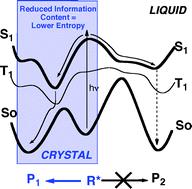Early photochemistry flourished with sunlight plus the experimental and intellectual infrastructure provided by the chemistry of organic compounds. Through the pioneering work of Giacomo Ciamician and Emanuele Paternò, it was shown that photochemical reactions give rise to products that are not accessible by thermal methods, and the green chemistry potential of organic photoreactions was already recognized at the time. Over the last century, the photochemical behavior of many chromophores and functional groups has been well documented in solution. From those studies, it has become clear that applications in organic synthesis suffer from complications arising from competing decay pathways that are intrinsic to those excited states. While there are few opportunities to control the outcome of excited molecules in solution, the potential of organic photochemistry under the influence of highly ordered structures can be appreciated with examples from photobiology. Knowing that nature can synthesize triglycerides with light, CO2, H2O and a few thermal reactions, organic photochemistry should have a great potential and aim high. With that in mind, after exploring the modes of action used by living organisms to take advantage of sunlight, one can identify an approach that relies on entropic factors that result from changes in the information content of the reactant. Analogies with information theory suggest a strategy that may be used to manage chemical information to modify the intrinsic properties of chromophores. Extrapolating from recent examples, it is suggested that an information-based approach to organic photochemistry may result in important advances not only in chemical synthesis and green chemistry, but also in many other applications.

You have access to this article
 Please wait while we load your content...
Something went wrong. Try again?
Please wait while we load your content...
Something went wrong. Try again?


 Please wait while we load your content...
Please wait while we load your content...